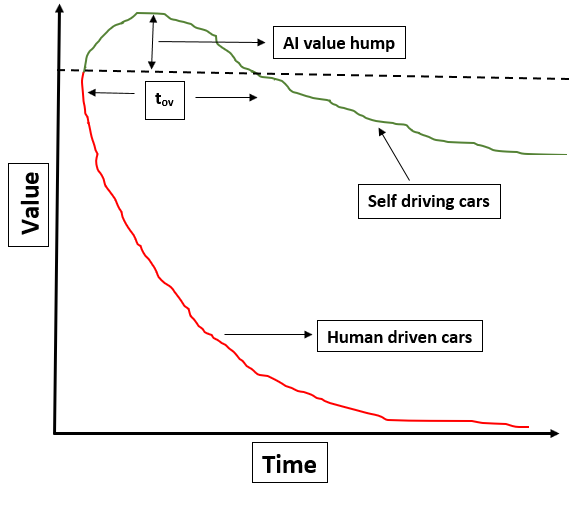The (New) Economics of Self Driving Cars
One fun thing I like to do is to imagine how AI will break down some of humanity's long held assumptions. One of such assumptions is that cars will always depreciate in value (of course barring special cases like having historical, sentimental or emotional value). This may not necessarily be the case for self driving cars and I'll explain why in this post.
The figure above shows a hypothesized plot comparing the rate of depreciation for a typical human driven car with a typical self driving car. As is well known, the human driven car depreciates exponentially - in fact, CARFAX estimates that a typical band new car looses 10% of its value just in the first month of leaving the car lot!.
However, I expect the value inherent in a new self driving vehicle's learning to turn such depreciation schedule on its head. This is because most tests on self driving vehicles are currently being done in controlled environments, hence their results, while very crucial to autonomous driving success, can at best be termed artificial. Only when such cars go live, in non-controlled environments can their learning data be termed real or practical. This, I believe will almost completely reverse the exponential depreciation rate humanity has come to expect from most vehicles.
Two (new) variables, in addition to the already common depreciation rate, can be used to characterize the depreciation schedule of self driving cars and these are the AI value hump and the time-to-original-value, tov.
AI Value Hump
The AI value hump represents the initial value increase that will happen once a self driving car goes live and begins to download its data to the cloud. The reason why this data download has value is because it helps in the design and learning of other self driving cars. It is not far fetched to imagine that the greatest AI value hump will be achieved by the very first set of self driving cars to drive on a given terrain, region or road network. As more self driving cars go live on such road networks, the AI value hump will start to decrease for each car. However, the rate of decrease of the AI value hump (characterized by the tov as described next) will be dependent on so many factors some of which will be regulatory and even the make of the vehicle.
Time-to-Original-Value (tov)
The time to original value is the time it takes for the AI value hump to completely decay to zero i.e. the time it takes for the car's value to return to the original price paid for the self driving car itself. The tov, as mentioned above, will be influenced by the depreciation rate during the AI value hump period and also by the value of the hump itself. The slower the depreciation rate the longer the tov will be. Hence, it is possible to have a low AI value hump but a long tov.

So what does this all mean? If you ever plan to purchase a self driving car, i.e. for revenue purposes, then the best time to do so will be as early as possible since that maximizes both the AI value hump and the tov you get.
However, as a disclaimer, please do your own research before making any investment decisions. I also have no financial interest in any company currently working on self driving cars.
Finally, if these terms or idea ever goes mainstream when self driving cars go online in the real world, remember you saw them here first.
aiplusfinance

@sbdpotato, @acidyo, @ocd, #posh also cross-posted on twitter
Congratulations @aiplusfinance! You have completed the following achievement on the Steem blockchain and have been rewarded with new badge(s) :
You can view your badges on your Steem Board and compare to others on the Steem Ranking
If you no longer want to receive notifications, reply to this comment with the word
STOPTo support your work, I also upvoted your post!
I took a class on artificial intelligence when I was in college. It was a fascinating class, but I came away from with a very important realization: artificial intelligence is anything but intelligent. It can only draw upon the input/output programmed into it. Learning AI can also only do so much. Now, if we build an AI that can pass the Turing Test, all bets are off.
How long ago did you take this class, if you don't mind me asking? AI has really come a long way since the last decade. You can research projects such as DeepMind and you'll be blown away with what AI can do today. You can also read some of my articles here on steemit such as part 1 and part 2 of my current series on the future of AI and even this quite interesting one asking if an AI algorithm will win the next AMA.
Admittedly, it was in 2006. So it has been more than a decade. I still stand by my assessment of input/output, though. It's...not nearly as intelligent as you might think.
I see your point and agree with your assessment of my optimism with AI. However, I liken my optimism with AI as a car traveling at 100 mph towards you - it makes no sense debating how long it will take before the car hits you, as it's an almost certainty that it will if you don't take action and get out of the way immediately! If we fail to act now, AI will hit humanity and for the unprepared, just as the impact of a moving car, the consequences might not be good.